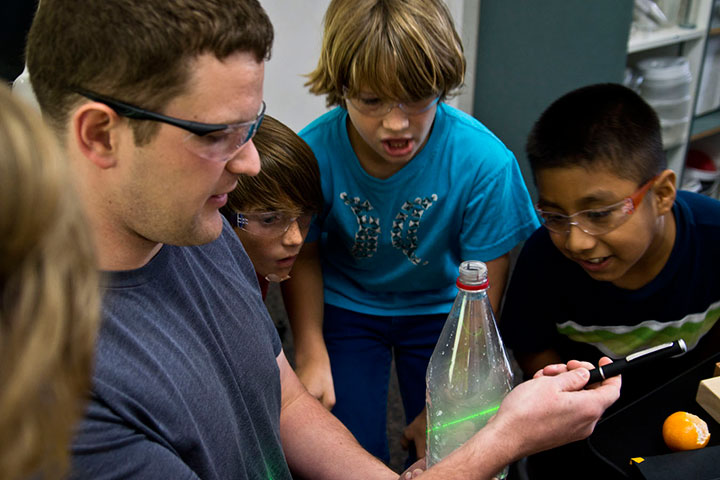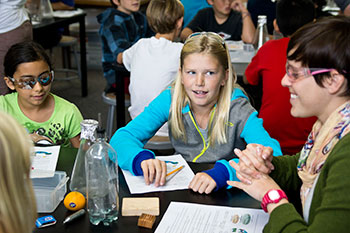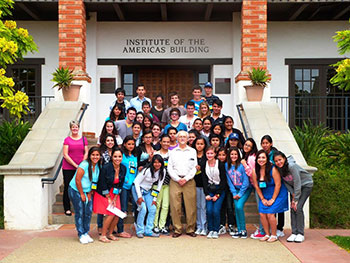
By:
- Robert Monroe
Published Date
By:
- Robert Monroe
Share This:
CAICE Outreach Program Creates Next Generation of Environmental Scientists

UC San Diego graduate student Jack Cahill uses a laser to illuminate a cloud manufactured inside a bottle at Paul Ecke Central Elementary School.
There are many age-appropriate ways to introduce people to the idea that there are among us infinitesimal tiny particles wafting through the air at any given moment, influencing the environment around us.
A first grader can appreciate that by seeing what kinds of particles can get trapped by a coffee filter and then what kinds get trapped by scientific-grade filters. Fifth-grade students can see particles at work in the formation of clouds they can create themselves inside 2-liter soda bottles. A Ph.D. student might analyze the chemical composition of a bacterium that has traveled across the Pacific Ocean, morphing and evolving before it reached the California coastline only to be fed into a specialized mass spectrometer capable of dissecting its chemical structure.
Aerosols are tiny vehicles that deliver elaborate chemistry that seeds clouds to produce rain (or not), scatter light to create blue skies at noon and red skies at sunset, or make one’s lungs hurt on a smoggy day. The Center for Aerosol Impacts on Climate and the Environment (CAICE) based at UC San Diego, which will receive a $20 million Phase II grant from the National Science Foundation (NSF), devotes a portion of its funds to the creation of scientists who will investigate the many roles aerosols play in nature and society. The effect of aerosols on the environment is something scientists and the general public have only begun to appreciate in recent years.
CAICE has been in existence for three years as an NSF Phase I Center for Chemical Innovation and has already begun that mission through science programs at K-12 schools throughout San Diego County, an annual hands-on presentation at Birch Aquarium at Scripps on the basics of aerosols and cloud formation, and a chemistry-climate curriculum package for fifth and sixth graders with international portability.

UC San Diego graduate student Kaitlyn Suski presides over student aerosol experiments at Paul Ecke Central Elementary School.
“CAICE not only has a research focus,” said CAICE Director Kim Prather, Distinguished Chair in Atmospheric Chemistry who holds appointments in the UC San Diego department of chemistry and biochemistry as well as at Scripps Institution of Oceanography. “There is a critical balance with its educational and outreach components. A major effort will be dedicated to creating the next generation of scientists who will tackle global environmental problems. The theme from top to bottom is environmental measurements and the goal is to reinvigorate interest in science.”
Twenty miles north of CAICE laboratories sits Paul Ecke Central Elementary School in Encinitas, Calif., where fifth-grade students have been introducing discoveries about aerosols into the annual science fair and presenting their findings to the Encinitas School District Board of Trustees. Matt Ruppel is a graduate student in Prather’s laboratory who has taken part in the Paul Ecke program for three years. In the past year, the aerosol research has grown from one-time classroom visits to a complete multi-month project in which the fifth-grade students design and build environmental measurement instruments and make measurements around their homes and school grounds, reporting on their findings at the end of the year. The program has been tailored so that it aligns with the Next Generation Science Standards.
Ruppel said CAICE researchers drew inspiration from the “We Can Change the World Challenge” sponsored by the technology firm Siemens in creating a program that lets students observe an environmental problem and then research the means to solve that problem. CAICE may apply to take part in the challenge this year. After watching the end-of-year presentations by the elementary school students he mentors, Ruppel feels even more inspired to grow CAICE’s outreach component.
“It’s really kind of amazing to hear what they’ve learned,” he said. “I know that I certainly didn’t know about any of this stuff when I was their age.”
Ruppel also takes part in SEA Days at Birch Aquarium at Scripps, an annual series of science presentations at the aquarium to introduce the public to current science endeavors at Scripps. There, UC San Diego students and scientists walk visitors through various demonstrations of aerosol science, inviting kids to blow bubbles into seawater to see how the carbon dioxide in their breath lowers the pH in the water, an analog for the global phenomenon of ocean acidification taking place now. Others pump up liter bottles filled with a small amount of water using bike pumps. The pressurized bottles then either produce small clouds or they don’t. Hint: They can’t form clouds without aerosols for the water vapor to cling to.
CAICE Director of Education and Outreach Skip Pomeroy had already been involved in outreach at his alma mater, Castle Park High School, in Chula Vista, Calif., when he began incorporating CAICE into the mix. The high school students now have become teachers themselves, he noted. They recently helped their young counterparts at Paul Ecke School learn how to make biodiesel fuel. Part of Pomeroy’s motivation is to make sure students with fewer science resources at their disposal are exposed to various frontiers of chemistry research. Aerosols, whose contributions to climate have only been comprehensively explored in recent decades, count as one of the most advanced of those frontiers.
“If you want to create the scientists of tomorrow and you want a diverse population involved, you have to start them early and I think all the members of our center embrace that idea,” said Pomeroy, a lecturer in chemistry at UC San Diego.

Camp Ciencia 2013, Mario Molina -- Nobel laureate and UC San Diego Distinguished Professor of Chemistry and Biochemistry Mario Molina met with high school students from several Latin American countries for a talk on environmental sustainability at the Institute of the Americas in summer 2013.
The effort is not limited to San Diego. Partners in CAICE outreach include 12 universities, as well as several agencies and private foundations. Under the aegis of CAICE outreach, for example, several dozen high school students from Latin American countries came to the Scripps Institution of Oceanography campus in July to study aerosol research. Many would probably count the talk on environmental sustainability by Nobel laureate Mario Molina–a CAICE member and UC San Diego distinguished professor of chemistry and biochemistry–as the highlight. Prather said that the kinds of science projects and curricula in use at Paul Ecke and Castle Park are being developed for use in other countries, which will be distributed by programs such as GLOBE, an NSF-supported earth system science education program managed by the University Corporation for Atmospheric Research.
Pomeroy notes that when the professors in CAICE began K-12 outreach, they brought their graduate students along to show them how to become teachers. It didn’t take long before the graduate students took over and led the outreach. For his part, Ruppel noticed how the fifth-grade students he oversaw needed only a little push before they were directing their own field research. Creation of self-motivated scientists is all part of the plan, said Pomeroy and Prather.
“The kids are designing their own experiments, analyzing data, arriving at conclusions, and developing solutions,” said Prather. “It’s not enough for us just to do science. We need to pass our findings onto others. We hope we’re creating researchers who are excited by science and interested in making a difference for their own as well as future generations.”
Share This:
You May Also Like
Stay in the Know
Keep up with all the latest from UC San Diego. Subscribe to the newsletter today.


